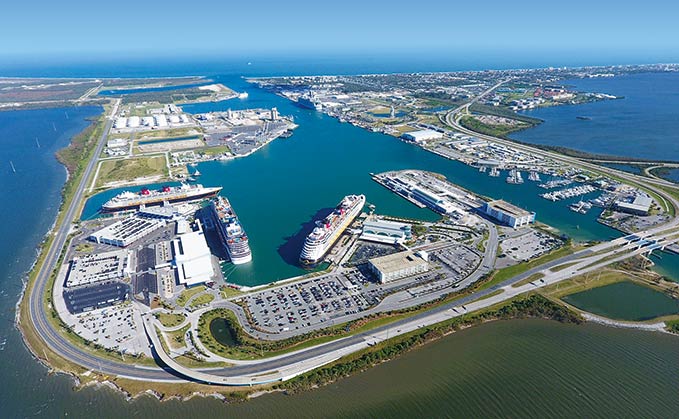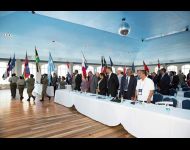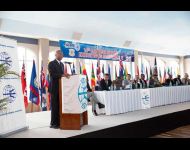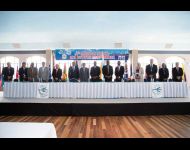Florida ports
Part of this effort includes the installation of crane rail infrastructure for new super post panamax container-handling gantry cranes. Port Everglades has ordered three such cranes at a cost of US$ 13.8 million each to meet the demand from existing customers and new services anticipated from the port’s multi-million-dollar expansion program. The port also has an option to buy an additional three cranes within the next five years.
To further enhance ship traffic at Port Everglades, the US Army Corps of Engineers is moving forward with plans to deepen the port’s navigation channels from 42 ft to 48-50 ft and to widen the narrower sections of the channel. This project is currently in the preconstruction engineering and design phase, having received Congressional authorization in December 2016. Deeper channels are needed to safely accommodate increasingly larger cargo ships, especially those already coming from Europe and South America that must be lightly loaded due to the existing water depth. The project addresses environmental concerns and will involve the restoration and protection of coral. Construction will take place in multiple phases and is expected to be completed between 2021 and 2025, an estimated three to five years after commencement. The estimated cost to date is US$ 389.3 million.
Improvements
As a result of major investments in terminal and transportation facilities, Port Everglades expects to generate returns that benefit the cruise industry as well as the port’s own bottom line.
Some of the improvements will be visible as soon as guests arrive at the port’s entrance. New directional signs that combine functionality with art are being installed throughout the port in 2018. Port officials are also working with Royal Caribbean Cruises to completely expand and remodel Cruise Terminal 25 for the arrival in November 2018 of the new ‘Celebrity Edge’.
In a public-private partnership, Carnival Corporation has made a multi-million-dollar investment in technology and aesthetics to transform Cruise Terminal 2 into the first and only facility in the world specially equipped for its new Ocean Medallion interactive wearable technology service.
In addition to facility improvements in time for the 2018-2019 season, Port Everglades will welcome two brand-new ships in December 2018 – the 2,918-passenger ‘Celebrity Edge’, described as ‘the ship designed to leave the future behind’, and the 2,650-passenger ‘Nieuw Statendam’, the newest Pinnacle-class ship to be introduced by long-time Port Everglades customer Holland America Line.
Port Everglades is the main import gateway for petroleum products for 12 counties in South Florida, including jet fuel for four international airports. In order to boost its petroleum receiving capacity, the port in conjunction with the petroleum industry is redeveloping Pier 1 by widening the adjacent slip by 150 ft and installing new offloading facilities. Starting in mid 2018 the petroleum industry will install a new manifold system – the first step of this multi-phase effort. The project is anticipated to be completed by 2026.
Landside, the port has completed several major public-private infrastructure projects to improve links with South Florida’s main highway and railroad systems.
One notable addition is a 43.4-acre near-dock Intermodal Container Transfer Facility (ICTF) owned and operated by the Florida East Coast Railway (FECR). This facility, opened three years ago, is located close to the majority of the port’s container terminals, thus allowing international containers to be transferred quickly between ship and rail. The US$ 72 million ICTF also handles domestic containers originating in or destined for the Eastern United States.
Overpass
To enhance productivity for over-the-road container movement, the Florida Department of Transportation (FDOT) invested US$ 42.5 million to build the Eller Drive Overpass connecting the east end of the I-595 interstate highway directly with the port’s main entrance. The overpass allows vehicles entering Port Everglades to travel unimpeded over two rail tracks that lead into the FECR’s intermodal facility. The I-595 highway gives direct access to I-95, I-75 and Florida’s Turnpike.
This year, Port Everglades officials will begin meeting with port stakeholders, customers and people in the port community to gather their input as it updates its 20-year master/vision plan. As Port Everglades continues to advance major infrastructure projects, all aimed at improving capacity and productivity, it will continue to serve as an ideal point of entry for products shipped around the world.
PORT CANAVERAL
Port Canaveral builds on hub status in cruise and cargo sectors
Canaveral Port Authority continues to make strategic investments in harbor and landside infrastructure improvements to augment the port’s mission as Central Florida’s premier maritime gateway. The port aims to be handling LNG-powered cruise and cargo ships by 2019.
Port Canaveral is a world-class strategic gateway for Central Florida – now the 10th-largest consumer market in the United States with economic growth well above the national average. The port is Florida’s third-largest by operating revenues, which are expected to exceed US$ 100 million in Fiscal Year 2018.
Port Canaveral is an economic driver for the region, with an annual impact of some US$ 2.2 billion. The Port Authority continues to invest in strategically planned improvements to meet the demands of commerce and tourism. Its goal is to sustain the port’s value as both a viable commercial entity and a community resource, while keeping pace with the global marketplace.

Port Canaveral is a popular homeport and port of call for some of the world’s largest and most sophisticated cruise ships. Nearly 5 million passengers are expected at the port this fiscal year, once again making it the world’s second-busiest cruise port. By 2019 it is expected to be the first US port capable of serving LNG-powered cruise and cargo vessels.
Direct access
Port Canaveral’s man-made deep-draft harbor offers direct access to the Atlantic Ocean, with a typical vessel transit time from first buoy to dock of only 45 minutes. The port’s central east coast Florida location and easy access to major road and rail systems puts it within three hours of every major Florida market. A larger market of 81 million consumers throughout Florida and into the south-eastern US can be reached within eight hours from Port Canaveral. These key advantages attracted nearly 6 million tons of diverse cargo through the port in 2017.
Investment decisions for the future will be driven by the port’s new Strategic Master Plan. This multi-year ‘look ahead’ includes near-term priorities of investments in expanded capabilities and infrastructure improvements that continue to advance the port’s business lines and recreational activities.
Several complex infrastructure projects will be initiated or completed at the port in the next two to five years. More than US$ 446 million, currently identified in the five-year capital improvement projects, will be invested in the construction and expansion of port facilities and infrastructure to allow the port to handle a projected growth in cruise and cargo operations. In response to demand by cruise and cargo partners, there will be crucial improvements to the road network. Revamped bulkhead will support the growing commercial space industry, which depends on Port Canaveral for recovery and relaunch operations.
Goals and objectives
- Sustain the port’s value as both a viable commercial entity and a community resource, while keeping pace with an increasingly complex global marketplace.
- Expand port capabilities and infrastructure to meet the growth needs of cargo, cruise and commercial space.
- Support rapid growth of Central Florida’s region and its demand for imports and exports with the port’s Foreign Trade Zone 136.
- Improve crucial road networks to support increased growth in cruise and cargo business.
- Provide critical infrastructure to support the commercial space industry that depends on the port for recovery and relaunch operations.
- Support the recreational needs of the local community.
Current or planned investments
- Construction of North Cargo Berth 8, a new multipurpose cargo berth to accommodate a growing cargo portfolio that includes commercial spacecraft components. This landside and waterside investment will provide the infrastructure and flexibility to handle a range of cargoes in response to growing demand.
- Replace Cruise Terminal 3, currently used for single-day port calls, with an expanded modern facility to serve cruise ships with up to 6,500 passengers. The port will invest an estimated US$ 150 million in the terminal, due for completion by the end of 2019, which will support nearly 4,000 permanent jobs.
- Develop operating scenario and related infrastructure to support earliest deliveries of LNG-powered cruise vessels at Port Canaveral.
- Manage the highest demand for bulkhead space in the history of the port with roadway expansions and improvements coupled with bulkhead renovations to meet changing requirements.
Accomplishments
- North Cargo Berths 5 and 6 renovated with 2,000 ft of quay deepened to 43 ft. The port is looking to purchase a mobile harbor crane with a reach of 18/19 containers.
- West Turning Basin deepened to the authorized depth of 43 ft plus 2 ft additional over-dredge to complement the existing authorized port channel depth of 44 ft. With the turning basin deepening project completed and the port’s channel clear from overhead obstructions such as bridges or wires, Port Canaveral can boast one of the deepest-draft working cargo berths with no air draft limitation between Miami, Florida, and Norfolk, Virginia.
- Completed US$ 54.5 million in capital investments in Fiscal Year 2017.
- Completed US$ 33.9 million renovation of Cruise Terminal 10 to support an increased number of cruise ship calls and sailings.
- Ro-ro terminal operator AutoPort Canaveral, LLC expanded original equipment manufacturer (OEM) auto imports nearly four-fold to meet the high demand from central and south Florida markets.
- Fuel terminal operator Seaport Canaveral completed a US$ 2 million truck lane expansion, nearly doubling the terminal’s automated loading capacity to handle up to 500 trucks per day. Truck volume is expected to exceed 120,000 this year.
Cruise
The US, Europe, The Bahamas and the Caribbean, Mexico and Central and South America.
Trade partners
Imports: Port Canaveral’s top five foreign trade partners (by tonnage) are The Bahamas, Canada, Venezuela, the Netherlands and France.
Exports: The port’s top five foreign trade partners (by tonnage) are the Netherlands, the Virgin Islands, Costa Rica, The Bahamas and Panama.
Issue 26 - October 2015 - January 2016
-
Harbour View
-
From the CSA President
-
Panama – new cranes for Manzanillo
-
Cartagena
-
Sail Cruising
-
Nicaragua Canal update
-
Cayman Islands
-
Port Lafito opening
-
Panama Canal update
-
Russbroker Caribbean market review
-
IT Investment
-
Contraband
-
CSA Diary - photo album
-
USA – new logistics center for Port Canaveral
-
Colombia – APM terminals in new joint venture
-
USA – new container terminal at Port Canaveral
-
Jamaica – KWL invests more
-
Cuba – cruise industry takes advantage of new political climate
-
Colombia – Puerto Bahía opens in Cartagena
-
Record passenger numbers for Carnival from New Orleans
-
Proposed Nicaragua Canal gets public vote
-
Panama Canal ‘on track for early 2016’
-
Tampa Bay gets security grant
-
Jumbo cruise ship heading to Florida
-
Clearing the Magdalena River
-
Boom in visitors to the region






















































